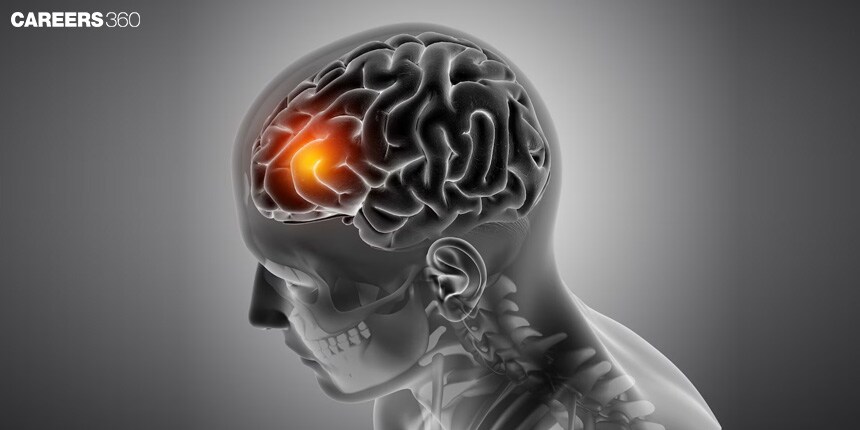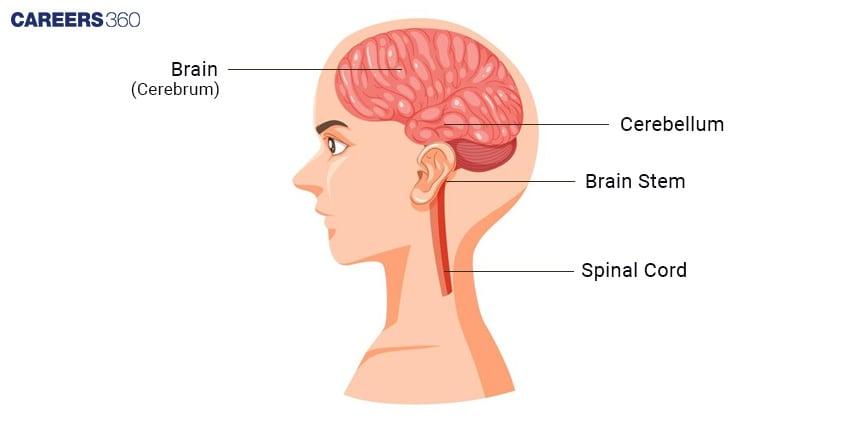Central Nervous System: Description, Development, Structure, Function, Diagram
Definition Of Central Nervous System (CNS)
The central nervous system consists of the brain and spinal cord and serves as the main control centre of the body. It processes all sensory information, provides responses, and maintains homeostasis.
Components Of Central Nervous System
There are two prime parts of CNS. They include the brain and the spinal cord.
Brain
The brain is divided into three major parts:
Cerebrum
This is the largest part and is responsible for higher brain functions such as thought, action, and sensory processing.
Divided into lobes: frontal, parietal, temporal, occipital. Each lobe has well-defined functions, such as reasoning, perceiving sensations, and perceiving visions.
NEET 2025: Mock Test Series | Syllabus | High Scoring Topics | PYQs
NEET Important PYQ's Subject wise: Physics | Chemistry | Biology
New: Meet Careers360 B.Tech/NEET Experts in your City | Book your Seat now
- Definition Of Central Nervous System (CNS)
- Components Of Central Nervous System
- Cells Of The Central Nervous System
- Function Of Central Nervous System
- Protection Of The Central Nervous System
- Disorders Of The CNS
- Recommended Video On ‘Central Nervous System’

Cerebellum
It controls balance, coordination, and fine muscle control.
Coordinates involuntary motions and maintains posture.
Brainstem
Further divided into midbrain, pons, and medulla oblongata.
It regulates all vital activities, like the heartbeat, breathing, and sleep cycles.
Joins the brain with the spinal cord; it controls automatic functions.
Spinal Cord
Comprised of cervical, thoracic, lumbar, sacral, and coccygeal segments.
Carry information between the brain and the rest of the body, and mediate reflex actions.
Diagram: Central Nervous System

Cells Of The Central Nervous System
There are two kinds of cells within the central nervous system:
Neurons
Cell Body (Soma): Contains the nucleus and metabolic machinery.
Dendrites: Receive the signals from other neurons.
Axon: Conducts electrical impulses away from the cell body.
Type Of Neurons
Sensory Neurons: Carry sensory information into the CNS
Motor Neurons: Carry signals from the CNS to muscles and glands.
Interneurons: Connect neurons, including other interneurons, within the CNS.
Glial Cells
The Types of glial cells are:
Astrocytes: Support and protection of neurons, maintenance of the blood-brain barrier.
Oligodendrocytes: Formation of myelin in the CNS
Microglia: Immune defence in the CNS
Ependymal Cells: Line ventricles.
Functions Of Glial Cells
To provide structural support, nourishment, and protection to neurons.
Function Of Central Nervous System
The functions of the CNS include:
Synaptic Transmission
A synapse includes the release of neurotransmitters by a presynaptic neuron, crossing the synaptic gap and binding to receptors of the postsynaptic neuron.
Chemical messengers, for example, dopamine, serotonin, and acetylcholine, modulate different CNS functions.
Reflex Actions
A reflex action tends to involve sensory input, integration in the spinal cord, and motor output without the inclusion of the brain.
Examples are the knee-jerk reflex and the withdrawal reflex to painful stimuli, both being of significance for rapid protective responses.
Protection Of The Central Nervous System
Dura Mater: Tough outer layer.
Arachnoid Mater: Middle web-like layer.
Pia Mater: Delicate inner layer adhering to the CNS surface.
Cerebrospinal Fluid (CSF)
Production, Circulation, and CSF Function.
Produced by the choroid plexus and flows through the ventricles and the subarachnoid space, cushioning the CNS, and removing waste.
Blood-Brain Barrier (BBB)
A selective barrier comprised of endothelial cells, astrocytes, and pericytes, which together protect the CNS from a wide range of injurious molecules.
Disorders Of The CNS
Multiple Sclerosis: Demyelination—causing such symptoms as muscle weakness or blindness.
Parkinson's Disease: Disruption in motor control due to the deficiency of dopamine; characterised by tremors and rigidity.
Alzheimer's Disease: From memory loss to the general cognitive decline of the patient.
The various disorders have characteristic symptoms and causes, with treatments ranging from medication for symptom management to physical therapy.
Recommended Video On ‘Central Nervous System’
Frequently Asked Questions (FAQs)
The CNS processes and integrates sensory information and responses, and controls most activities of the body and mind.
Neurons communicate by synapses, where neurotransmitters are released to carry on the signal across cells.
Symptoms might include the loss of movement, sensation, or function below the level of injury.
Protective measures include helmets, avoiding smoking, a healthy diet, and keeping a regular level of exercise.
Currently under development are studies on neuroplasticity, stem cell therapy, MRI technologies, and brain-computer interfaces.
Also Read
30 Nov'24 10:55 AM
29 Nov'24 08:48 PM
29 Nov'24 06:52 PM
29 Nov'24 05:35 PM